By Stephen Cormier
Product Sales Specialist, IRD
Sometimes it seems like everyone is in a hurry – rushing to get to work, late for an important appointment, or even competing with other cars to get to the next intersection first. Whether it’s human nature or the result of the ever-quickening pace of the modern world, we’ve all seen it in action. There are times, though, when we need to slow things down to protect vulnerable people: children on their way to school, seniors visiting a medical center, workers on paving projects, or paramedics helping people at the site of a car accident. In those situations, a speed display sign can effectively remind drivers to slow down for safety.
What are radar speed signs?
Radar speed signs, also referred to as Dynamic Speed Display Signs (DSDS), are variable message signs that display the speed of approaching vehicles. When IRD acquired Icoms Detections, we also got two of the best radar speed signs on the market. After some development work to make the signs fully compliant with MUTCD, we’ve added the signs to our North American product line. The new North American model displays the speed in the required yellow on black, while a version that varies the color displayed based on speed (green/orange/red) is still available for the rest of the world. Color changing signs are also a good option for applications such as construction sites and private facilities.
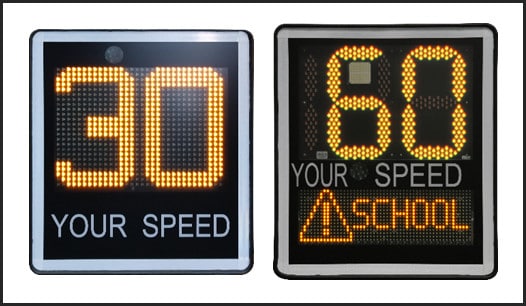
Both the I-SAFE 1 and I-SAFE 2 models offer something more than basic speed display signs. The I-SAFE 1 can display customized pictograms, and the I-SAFE 2 displays a customizable text message below the vehicle speed. These features are valuable as the addition of features such as color changes, strobes, and text messages have been shown to increase the effectiveness of dynamic speed display signs in getting drivers to slow down.
Getting Drivers’ Attention
Radar Speed Signs work by getting the driver to notice their speed and take action. Dynamic speed signs increase in their effectiveness as they progress from simple speed display through color changes and custom messaging:
IRD supplies radar sign models with these sign features, but also offers one more attention-getting method. All I-SAFE signs are equipped with a strobe that can be activated at a speed threshold. This feature is best reserved for drivers travelling well over the limit who need an insistent reminder that they are exceeding a safe speed.
Effectiveness vs sign features

Good
Driver’s actual speed displayed.
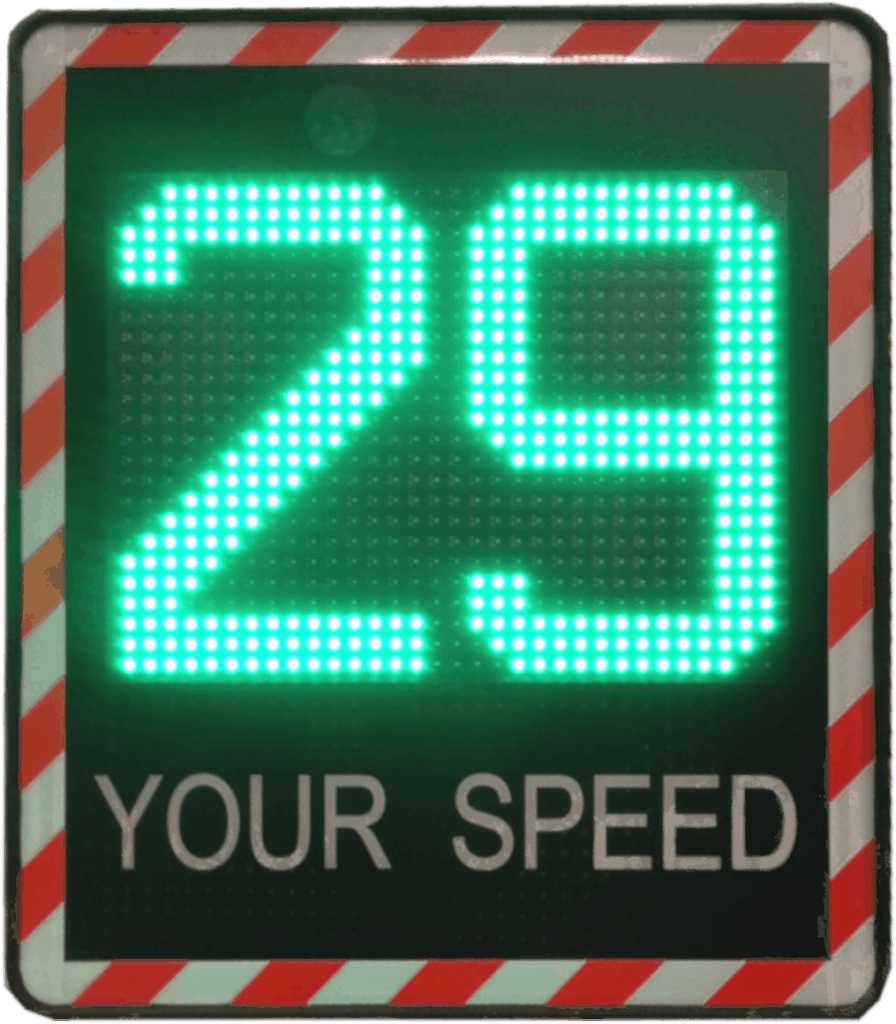
Better
The color of the speed changes. For instance a legal speed may appear green, and a speed over the legal limit may appear red.
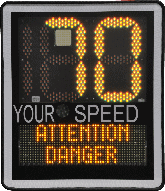
Best
Customized icon or message accompanies the driver’s speed. For example, “SLOW DOWN” or “DANGER”.
Deciding When to Use a Radar Speed Sign
In some locations, such as school zones or work zones, there are clearly vulnerable people at risk and a radar speed sign is warranted. But how do you decide when to put a radar speed sign on a normal residential street? A commonly-used guideline used by traffic engineers is to say that a radar speed sign is justified when the observed 85th percentile speeds at a site exceed the posted speed limit by 5 mph (8 km/h) or more. However, this isn’t necessarily intuitive to the general public and may not be the only factor considered. Some other factors that suggest a radar speed sign should be considered for a site are:
- high traffic volumes
- a history of speed-related accidents
- a history of pedestrian/vehicle accidents
- a recent change to the posted speed limit
Possibly the biggest factor isn’t based on data and statistics at all but on public perception. If people think that a street close to their home has a lot of speeding drivers, they may ask their local government to improve safety. In these instances a portable radar speed sign can give the responsible agency a quick solution, while also collecting data to see if further traffic calming or other measures to reduce speeds are merited on the basis of objective criteria.
Data and Effectiveness
Once you’ve started using radar speed signs, how do you know that they’re an effective part of your safety program? Unless you have an awful lot of accidents at a site, you won’t get an immediately measureable reduction in accidents, so how do you evaluate your speed sign program? Well, I-SAFE speed signs have a solution built in – both the I-SAFE 1 and I-SAFE 2 are able to collect data while operating. The traffic data collected by the sign can be easily downloaded to a Windows computer connected with Bluetooth, or it may be transferred to a USB flash drive.
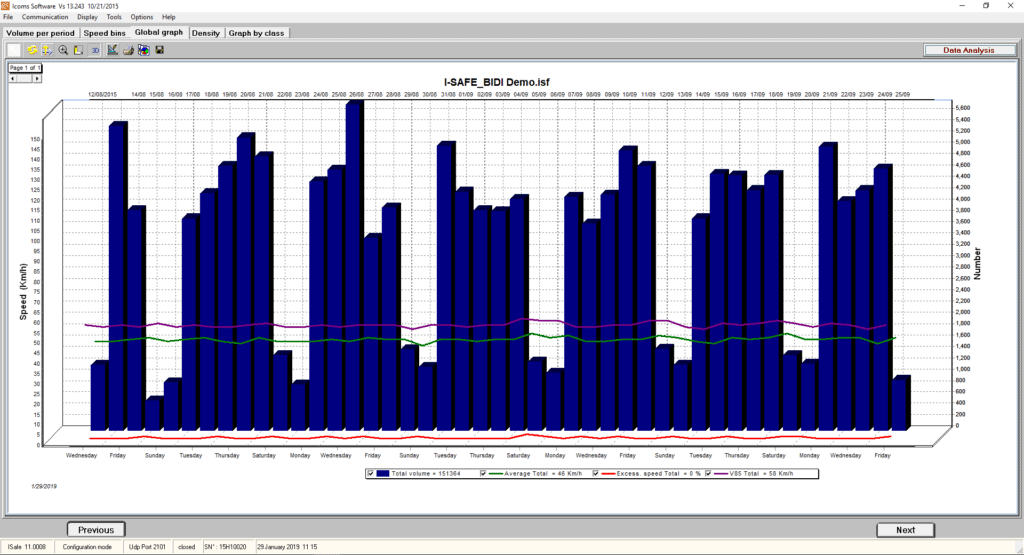
Portability
At roadwork or emergency response sites, it makes sense to use portable signs that can be set up for the period of time workers will be at the site. In traffic calming applications, studies have shown radar speed display signs are most effective at reducing vehicle speeds when first installed, so it can be an effective strategy to raise awareness of vulnerable road users at one site and then move the radar speed sign to another site to get the “new sign effect” again. IRD’s I-SAFE signs use a battery pack for portable power that lasts weeks between charges.
Speed vs. Safety
We started this post by noting some situations when it is desirable to slow down traffic, but how clear is the relationship between vehicle speed and pedestrian safety? With today’s revolution in city planning and design, we can expect non-motorized traffic to increase. With more pedestrians and bicycles on our streets, it’s become very important to understand the risks faced by vulnerable road users. Studies have shown that higher speeds result in both higher accident rates and higher fatality rates when accidents occur. Over about 35 mph (60 km/h) the fatality rate rises rapidly in passenger car/pedestrian accidents. [1]
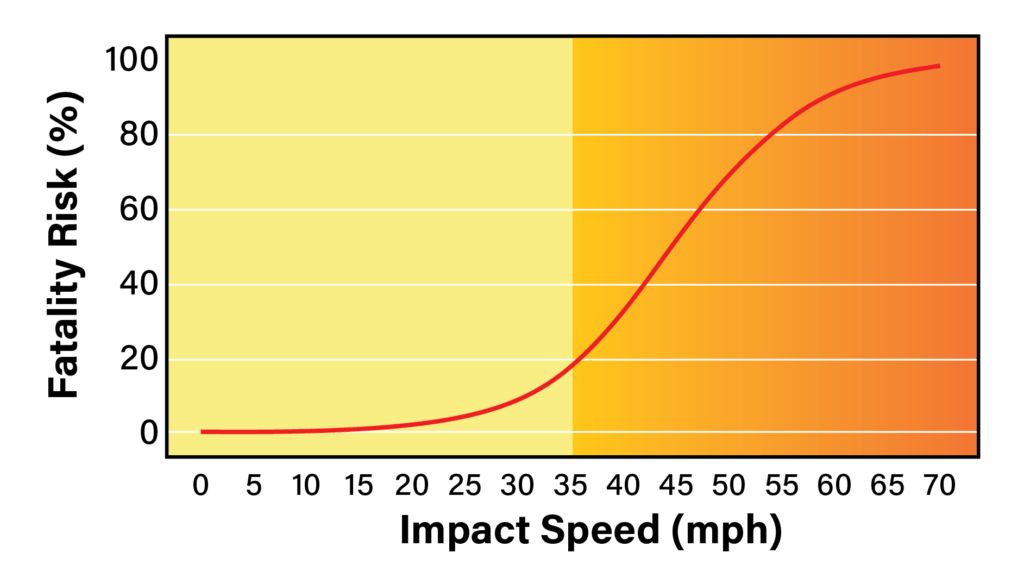
Encouraging drivers to limit their speed in pedestrian areas is a major factor in preventing fatal collisions.
[1] Rosén, E., U. Sander (2009). Pedestrian fatality risk as a function of car impact speed., Accident; analysis and prevention.
Originally published on IRD’s blog: https://www.irdinc.com/blog/details/isafe_are_you.html
